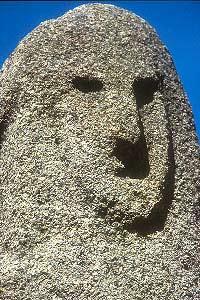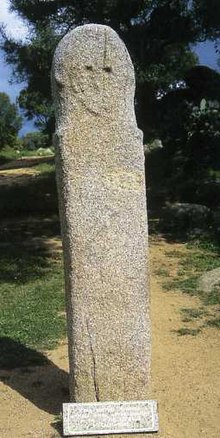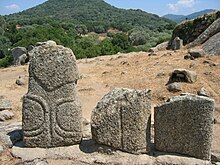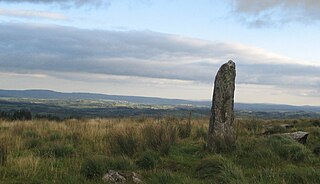
A menhir, standing stone, orthostat, or lith is a large upright stone, emplaced in the ground by humans, typically dating from the European middle Bronze Age. They can be found individually as monoliths, or as part of a group of similar stones. Menhirs' size can vary considerably, but they often taper toward the top.

A megalith is a large stone that has been used to construct a prehistoric structure or monument, either alone or together with other stones. There are over 35,000 in Europe alone, located widely from Sweden to the Mediterranean sea.

Locmariaquer is a commune in the Morbihan department in Brittany in north-western France.
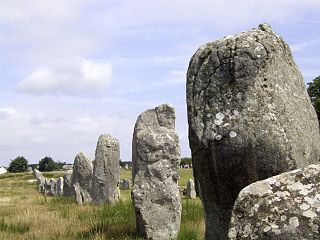
The Carnac stones are an exceptionally dense collection of megalithic sites near the south coast of Brittany in northwestern France, consisting of stone alignments (rows), dolmens, tumuli and single menhirs. More than 3,000 prehistoric standing stones were hewn from local granite and erected by the pre-Celtic people of Brittany and form the largest such collection in the world. Most of the stones are within the Breton municipality of Carnac, but some to the east are within neighboring La Trinité-sur-Mer. The stones were erected at some stage during the Neolithic period, probably around 3300 BC, but some may date to as early as 4500 BC.

Gavrinis is a small island in the Gulf of Morbihan in Brittany, France. It contains the Gavrinis tomb, a megalithic monument notable for its abundance of megalithic art in the European Neolithic. Administratively, it is part of the commune of Larmor-Baden.

The Cairn of Barnenez is a Neolithic monument located near Plouezoc'h, on the Kernéléhen peninsula in northern Finistère, Brittany (France). It dates to the early Neolithic, about 4800 BC. Along with the Tumulus of Bougon and Locmariaquer megaliths, also located in Great West France, it is one of the earliest megalithic monuments in Europe and one of the oldest man-made structures in the world. It is also remarkable for the presence of megalithic art.

The prehistory of Corsica is analogous to the prehistories of the other islands in the Mediterranean Sea, such as Sicily, Sardinia, Malta and Cyprus, which could only be accessed by boat and featured cultures that were to some degree insular; that is, modified from the traditional Paleolithic, Mesolithic, Neolithic and Chalcolithic of European prehistoric cultures. The islands of the Aegean Sea and Crete early developed Bronze Age civilizations and are accordingly usually treated under those categories. Stone Age Crete however shares some of the features of the prehistoric Mediterranean islands.

The Locmariaquer megaliths are a complex of Neolithic constructions in Locmariaquer, Brittany. They comprise the elaborate Er-Grah tumulus passage grave, a dolmen known as the Table des Marchand and "The Broken Menhir of Er Grah", the largest known single block of stone to have been transported and erected by Neolithic people.

Cuccuruzzu is an archaeological site in Corsica. It is located in the commune of Levie.

The Menhir de Champ-Dolent is a menhir, or upright standing stone, located in a field outside the town of Dol-de-Bretagne. It is the second largest standing stone in Brittany and is over 9 meters high.

Monte d'Accoddi is a Neolithic archaeological site in northern Sardinia, located in the territory of Sassari. The site consists of a massive raised stone platform thought to have been an altar. It was constructed by the Ozieri culture or earlier, with the oldest parts dated to around 4,000–3,650 BC.

The Torrean civilization was a Bronze Age megalithic civilization that developed in Southern Corsica, mostly concentrated south of Ajaccio, during the second half of the second millennium BC.
Frederica Dorothy Violet Carrington, Lady Rose, MBE was an expatriate British writer domiciled for over half her life in Corsica. She was one of the twentieth century's leading scholars on the island's culture and history, about which she wrote numerous books and articles.

Roger Grosjean was a French Air Force pilot, a double agent during World War II, and one of the founding fathers of Corsican prehistoric archaeology.

The history of Corsica in ancient times was characterised by contests for control of the island among various foreign powers. The successors of the neolithic cultures of the island were able to maintain their distinctive traditions even into Roman times, despite the successive interventions of Etruscans, Carthaginians or Phoenicians, and Greeks. A long period of Roman rule was followed by renewed conflict for control of the island by the Vandals, Byzantines and Saracens.

Erbalunga or Erbalonga is an ancient fishing village on Cap Corse, in the municipality of Brando in the French department of Haute-Corse, Corsica. The village of Erbalonga is the most northerly coastal settlement of Cap Corse, with vertiginous roads and sloping maquis beyond.

The Dolmen of Guadalperal, also known as the treasure of Guadalperal and as the Spanish Stonehenge for its resemblance to the English Stonehenge, is a megalithic monument dating from between 2000 and 3000 BC in Peraleda de la Mata, a town in the region of Campo Arañuelo in eastern Extremadura, Spain. The monument is within the Valdecañas reservoir in the Tagus River and is only visible when the water level allows it.

The Menhir of Patalou is located in the Nisa municipality in the Portalegre District of Portugal, about 5km from the town of Nisa. The menhir is a megalithic standing stone dating back to the 5th millennium BCE. It is believed to be the second oldest example of a menhir to be identified in Western Europe.

La Torre-La Janera megalithic site is located in the municipalities of Ayamonte and Villablanca in the province of Huelva, Andalusia. It was discovered when in 2018 a farmer intended to prepare the land to cultivate avocados and in view of the archaeological potential of the site the local council demanded a survey to be made. It is considered to be one of the largest megalithic site in Europe with over 500 standing stones.
